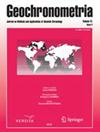石英颗粒的内剂量率:实验数据和发光测年结果
IF 0.9
4区 地球科学
Q3 Earth and Planetary Sciences
引用次数: 0
摘要
摘要这项工作考虑了从砂质沉积物中获得的石英颗粒中的内部α和β剂量率对发光测年结果的影响。本文报告的内部剂量率(约0.01–0.21 Gy·ka−1)起着特别重要的作用,因为外部剂量率较低(约0.8–0.9 Gy·ka−1)或非常低(约0.4–0.6 Gy·卡−1)。在这些情况下,内部剂量率在总剂量率中占很大比例,通常超过10%。忽略这一贡献会使所考虑的发光年龄人为地变老。在我们的研究中,我们测量了内部α和β的贡献,因为后者在石英的情况下通常被忽略。使用创新的μ剂量系统进行剂量率测量。本文章由计算机程序翻译,如有差异,请以英文原文为准。
The Internal Dose Rate in Quartz Grains: Experimental Data and Consequences for Luminescence Dating
Abstract This work considers the impact of the internal alpha and beta dose rates in quartz grains obtained from sandy sediments on the results of luminescence dating. The internal dose rates reported here (ca. 0.01–0.21 Gy · ka−1) play a particularly important role, because of low (ca. 0.8–0.9 Gy · ka−1) or very low (ca. 0.4–0.6 Gy · ka−1) external dose rates. In these cases, the internal dose rates form a significant fraction of the total dose rates, often exceeding 10%. Ignoring this contribution would have made the considered luminescence ages artificially older. In our study, we measure both the internal alpha and beta contributions as the latter is usually neglected in the case of quartz. The dose rate measurements were performed using the innovative μDose system.
求助全文
通过发布文献求助,成功后即可免费获取论文全文。
去求助
来源期刊

Geochronometria
地学-地球科学综合
CiteScore
2.20
自引率
0.00%
发文量
1
审稿时长
>12 weeks
期刊介绍:
Geochronometria is aimed at integrating scientists developing different methods of absolute chronology and using them in different fields of earth and other natural sciences and archaeology. The methods in use are e.g. radiocarbon, stable isotopes, isotopes of natural decay series, optically stimulated luminescence, thermoluminescence, EPR/ESR, dendrochronology, varve chronology. The journal publishes papers that are devoted to developing the dating methods as well as studies concentrating on their applications in geology, palaeoclimatology, palaeobiology, palaeohydrology, geocgraphy and archaeology etc.
 求助内容:
求助内容: 应助结果提醒方式:
应助结果提醒方式:


